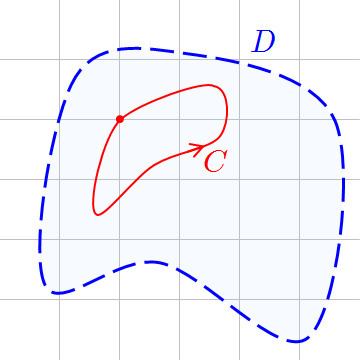 | ||
In complex analysis, a branch of mathematics, Morera's theorem, named after Giacinto Morera, gives an important criterion for proving that a function is holomorphic.
Contents
Morera's theorem states that a continuous, complex-valued function ƒ defined on an open set D in the complex plane that satisfies
for every closed piecewise C1 curve
The assumption of Morera's theorem is equivalent to that ƒ has an antiderivative on D.
The converse of the theorem is not true in general. A holomorphic function need not possess an antiderivative on its domain, unless one imposes additional assumptions. The converse does hold e.g. if the domain is simply connected; this is Cauchy's integral theorem, stating that the line integral of a holomorphic function along a closed curve is zero.
The standard counterexample is the function f(z) = 1/z, which is holomorphic on ℂ - {0}. On any simply connected neighborhood U in ℂ - {0}, 1/z has an antiderivative defined by L(z) = ln(r) + iθ, where z = r eiθ. Because of the ambiguity of θ up to the addition of any integer multiple of 2π, any continuous choice of θ on U will suffice to define an antiderivative of 1/z on U. (It is the fact that θ cannot be defined continuously on a simple closed curve containing the origin in its interior that is the root of why 1/z has no antiderivative on its entire domain ℂ - {0}.) And because the derivative of an additive constant is 0, any constant may be added to the antiderivative and it's still an antiderivative of 1/z.
In a certain sense, the 1/z counterexample is universal: For every analytic function that has no antiderivative on its domain, the reason for this is that 1/z itself does not have an antiderivative on ℂ - {0}.
Proof
There is a relatively elementary proof of the theorem. One constructs an anti-derivative for ƒ explicitly.
Without loss of generality, it can be assumed that D is connected. Fix a point z0 in D, and for any
To see that the function is well-defined, suppose
And it follows that
Then using the continuity of ƒ to estimate difference quotients, we get that F′(z) = ƒ(z). Had we chosen a different z0 in D, F would change by a constant: namely, the result of integrating f along any piecewise regular curve between the new z0 and the old, and this does not change the derivative.
Note that we can apply neither the Fundamental theorem of Calculus nor the mean value theorem since they are only true of real-valued functions.
Since f is the derivative of the holomorphic function F, it is holomorphic. The fact that derivatives of holomorphic functions are holomorphic can be proved by using the fact that holomorphic functions are analytic, i.e. can be represented by a convergent power series, and the fact that power series may be differentiated term by term. This completes the proof.
Applications
Morera's theorem is a standard tool in complex analysis. It is used in almost any argument that involves a non-algebraic construction of a holomorphic function.
Uniform limits
For example, suppose that ƒ1, ƒ2, ... is a sequence of holomorphic functions, converging uniformly to a continuous function ƒ on an open disc. By Cauchy's theorem, we know that
for every n, along any closed curve C in the disc. Then the uniform convergence implies that
for every closed curve C, and therefore by Morera's theorem ƒ must be holomorphic. This fact can be used to show that, for any open set Ω ⊆ C, the set A(Ω) of all bounded, analytic functions u : Ω → C is a Banach space with respect to the supremum norm.
Infinite sums and integrals
Morera's theorem can also be used in conjunction with Fubini's theorem and the Weierstrass M-test to show the analyticity of functions defined by sums or integrals, such as the Riemann zeta function
or the Gamma function
Specifically one shows that
for a suitable closed curve C, by writing
and then using Fubini's theorem to justify changing the order of integration, getting
Then one uses the analyticity of α ↦ xα−1 to conclude that
and hence the double integral above is 0. Similarly, in the case of the zeta function, the M-test justifies interchanging the integral along the closed curve and the sum.
Weakening of hypotheses
The hypotheses of Morera's theorem can be weakened considerably. In particular, it suffices for the integral
to be zero for every closed triangle T contained in the region D. This in fact characterizes holomorphy, i.e. ƒ is holomorphic on D if and only if the above conditions hold.
